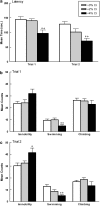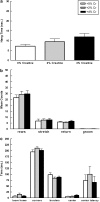Chronic creatine supplementation alters depression-like behavior in rodents in a sex-dependent manner
- PMID: 19829292
- PMCID: PMC2794979
- DOI: 10.1038/npp.2009.160
Chronic creatine supplementation alters depression-like behavior in rodents in a sex-dependent manner
Abstract
Impairments in bioenergetic function, cellular resiliency, and structural plasticity are associated with the pathogenesis of mood disorders. Preliminary evidence suggests that creatine, an ergogenic compound known to promote cell survival and influence the production and usage of energy in the brain, can improve mood in treatment-resistant patients. This study examined the effects of chronic creatine supplementation using the forced swim test (FST), an animal model selectively sensitive to antidepressants with clinical efficacy in human beings. Thirty male (experiment 1) and 36 female (experiment 2) Sprague-Dawley rats were maintained on either chow alone or chow blended with either 2% w/w creatine monohydrate or 4% w/w creatine monohydrate for 5 weeks before the FST. Open field exploration and wire suspension tests were used to rule out general psychostimulant effects. Male rats maintained on 4% creatine displayed increased immobility in the FST as compared with controls with no differences by diet in the open field test, whereas female rats maintained on 4% creatine displayed decreased immobility in the FST and less anxiety in the open field test compared with controls. Open field and wire suspension tests confirmed that creatine supplementation did not produce differences in physical ability or motor function. The present findings suggest that creatine supplementation alters depression-like behavior in the FST in a sex-dependent manner in rodents, with female rats displaying an antidepressant-like response. Although the mechanisms of action are unclear, sex differences in creatine metabolism and the hormonal milieu are likely involved.
Figures






References
-
- Agren H, Niklasson F. Creatinine and creatine in CSF: indices of brain energy metabolism in depression. J Neural Transm. 1988;74:55–59. - PubMed
-
- Amital D, Vishne T, Roitman S, Kotler M, Levine J. Open study of creatine monohydrate in treatment-resistant posttraumatic stress disorder. J Clin Psychiatry. 2006;67:836–837. - PubMed
-
- Andres RH, Ducray AD, Schlattner U, Wallimann T, Widmer HR. Functions and effects of creatine in the central nervous system. Brain Res Bull. 2008;76:329–343. - PubMed
-
- Andres RH, Huber AW, Schlattner U, Perez-Bouza A, Krebs SH, Seiler RW, et al. Effects of creatine treatment on the survival of dopaminergic neurons in cultured fetal ventral mesencephalic tissue. Neuroscience. 2005;133:701–713. - PubMed
-
- Armario A, Gavaldà A, Martí O. Forced swimming test in rats: effect of desipramine administration and the period of exposure to the test on struggling behavior, swimming, immobility and defecation rate. Eur J Pharmacol. 1988;158:207–212. - PubMed
Publication types
MeSH terms
Substances
Grants and funding
LinkOut - more resources
Full Text Sources
Other Literature Sources
Medical
Miscellaneous

